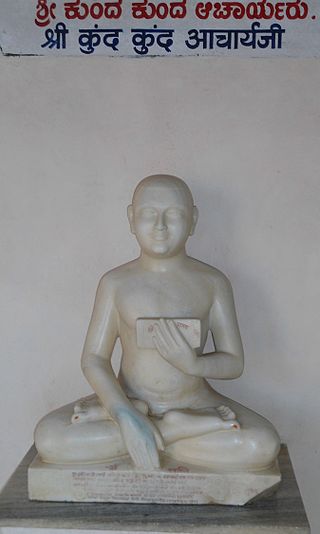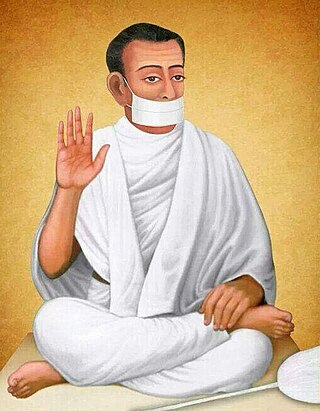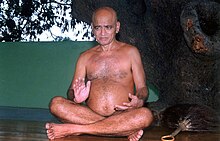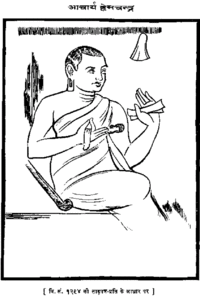
The Śvetāmbara is one of the two main branches of Jainism, the other being the Digambara. Śvetāmbara in Sanskrit means "white-clad", and refers to its ascetics' practice of wearing white clothes, which sets it apart from the Digambara or "sky-clad" Jains whose ascetic practitioners go nude. Śvetāmbaras do not believe that ascetics must practice nudity.

Hemachandra was a 12th century Indian Jain saint, scholar, poet, mathematician, philosopher, yogi, grammarian, law theorist, historian, lexicographer, rhetorician, logician, and prosodist. Noted as a prodigy by his contemporaries, he gained the title kalikālasarvajña, "the knower of all knowledge in his times" and father of the Gujarati language.

Parshvanatha, or Pārśva and Pārasanātha, was the 23rd of 24 Tirthankaras of Jainism. He gained the title of Kalīkālkalpataru.

Ācārya Bhadrabāhu was, according to both the Śvetāmbara and Digambara sects of Jainism, the last Shruta Kevalin in Jainism.

Kunda kunda was a Digambara Jain monk and philosopher, who likely lived in the second century CE or later.

Acharya Bhikshu (1726–1803) was the founder and first spiritual head of the Śvetāmbara Terapanth sect of Jainism.

Jain monasticism refers to the order of monks and nuns in the Jain community and can be divided into two major denominations: the Digambara and the Śvētāmbara. The monastic practices of the two major sects vary greatly, but the major principles of both are identical. Five mahāvratas, from Mahavira's teachings, are followed by all Jain ascetics of both the sects. Historians believe that a united Jain sangha (community) existed before 367 BCE, about 160 years after the moksha (liberation) of Mahavira. The community then gradually divided into the major denominations. However, no evidences indicate when the schism between the Digambaras and the Śvetāmbaras happened.

The Bhaktāmara Stotra is a Jain religious hymn (stotra) written in Sanskrit. It was authored by Manatunga. The Digambaras believe it has 48 verses while Śvetāmbaras believe it consists of 44 verses.
Siddhasēna Divākara was a jain monk of the Śvetāmbara sect in the fifth century CE who wrote works on Jain philosophy and epistemology. He was like the illuminator of the Jain order and therefore came to be known as Divākara, "Sun". He is credited with the authorship of many books, most of which are not available. Sanmatitarka is the first major Jain work on logic written in Sanskrit. Among the most popular of his works, the Kalyan Mandir Stotra is a Sanskrit hymn dedicated to the 23rd Tirthankara Parshvanatha. It is one of the 9 holiest recitations in the Śvetāmbara Murtipujak sect of Jainism.
Jainism is a religion founded in ancient India. Jains trace their history through twenty-four tirthankara and revere Rishabhanatha as the first tirthankara. The last two tirthankara, the 23rd tirthankara Parshvanatha and the 24th tirthankara Mahavira are considered historical figures. According to Jain texts, the 22nd tirthankara Neminatha lived about 5,000 years ago and was the cousin of Krishna.

Sthulabhadra was the prominent Jain Acharya in third or fourth-century BC. He was a disciple of Bhadrabahu and Sambhutavijaya. His father was Sakatala, a minister in Nanda kingdom before the arrival of Chandragupta Maurya. When his brother became the chief minister of the kingdom, Sthulabhadra became a Jain monk and suceeded Bhadrabahu in the Pattavali as per the writings of the Kalpa Sūtra. He is mentioned in the 12th-century Jain text by Hemachandra.

Jain literature refers to the literature of the Jain religion. It is a vast and ancient literary tradition, which was initially transmitted orally. The oldest surviving material is contained in the canonical Jain Agamas, which are written in Ardhamagadhi, a Prakrit language. Various commentaries were written on these canonical texts by later Jain monks. Later works were also written in other languages, like Sanskrit and Maharashtri Prakrit.

Sukhlal Sanghvi, also known as Pandit Sukhlalji, was a Jain scholar and philosopher. He belonged to the Sthanakvasi sect of Jainism. Pandit Sukhlal lost his eyesight at the age of sixteen on account of smallpox. However, he persisted and became profoundly versed in Jain logic and rose to become a professor at Banaras Hindu University. Paul Dundas calls him one of the most incisive modern interpreters of Jain philosophy. Dundas notes that Sanghavi represents what now seems to be a virtually lost scholarly and intellectual world. He was a mentor for famous Jain scholar Padmanabh Jaini. During his lifetime he won such awards as the Sahitya Akademi Award and won recognition from the Government of India by getting Padma Bhushan award. Sukhlalji was also known as Pragnachaksu because he was so vastly learned despite being visually disabled.

Yashovijaya, a seventeenth-century Jain philosopher-monk, was a notable Indian philosopher and logician. He was a thinker, prolific writer and commentator who had a strong and lasting influence on Jainism. He was a disciple of Muni Nayavijaya in the lineage of Jain monk Hiravijaya who influenced the Mughal Emperor Akbar to give up eating meat. He is also known as Yashovijayji with honorifics like Mahopadhyaya or Upadhyaya or Gani.

Umaswati, also spelled as Umasvati and known as Umaswami, was an Indian scholar, possibly between 2nd-century and 5th-century CE, known for his foundational writings on Jainism. He authored the Jain text Tattvartha Sutra. Umaswati's work was the first Sanskrit language text on Jain philosophy, and is the earliest extant comprehensive Jain philosophy text accepted as authoritative by all four Jain traditions. His text has the same importance in Jainism as Vedanta Sutras and Yogasutras have in Hinduism.

Digambara is one of the two major schools of Jainism, the other being Śvetāmbara (white-clad). The Sanskrit word Digambara means "sky-clad", referring to their traditional monastic practice of neither possessing nor wearing any clothes.

Acharya Manatunga was the author of the Jain prayer Bhaktamara Stotra. His name only appears in the last stanza of the said prayer. He is also credited with composing another Śvetāmbara hymn titled Namiun Stotra or Bhayahara Stotra, an adoration of Parshvanatha.

Jainism is an Indian religion which is traditionally believed to be propagated by twenty-four spiritual teachers known as tirthankara. Broadly, Jainism is divided into two major schools of thought, Digambara and Śvetāmbara. These are further divided into different sub-sects and traditions. While there are differences in practices, the core philosophy and main principles of each sect is the same.

Acharya Ravisena was a seventh century Digambara Jain Acharya, who wrote Padmapurana in Sanskrit in 678 AD. In Padmapurana, he mentions about a ceremony called suttakantha, which means the thread hanging from neck.























